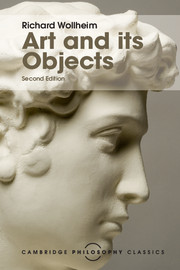Book contents
- Frontmatter
- Dedication
- Contents
- Preface to this edition
- Preface to the second edition
- The argument
- Art and its objects
- Supplementary essays
- 1 The Institutional theory of art
- 2 Are the criteria of identity for works of art aesthetically relevant?
- 3 A note on the physical object hypothesis
- 4 Criticism as retrieval
- 5 Seeing-as, seeing-in, and pictorial representation
- 6 Art and evaluation
- Bibliography
6 - Art and evaluation
from Supplementary essays
Published online by Cambridge University Press: 05 November 2015
- Frontmatter
- Dedication
- Contents
- Preface to this edition
- Preface to the second edition
- The argument
- Art and its objects
- Supplementary essays
- 1 The Institutional theory of art
- 2 Are the criteria of identity for works of art aesthetically relevant?
- 3 A note on the physical object hypothesis
- 4 Criticism as retrieval
- 5 Seeing-as, seeing-in, and pictorial representation
- 6 Art and evaluation
- Bibliography
Summary
An omission from Art and its Objects, and a deliberate omission, was the topic of the evaluation of art. This was largely a response to two tendencies of thought, then (1966–7) prevailing in academic aesthetics, and from which I wanted to dissociate my book.
One tendency came to aesthetics from outside philosophy, the other from within philosophy. The first consisted in isolating the evaluation of art from other, more cognitive approaches to art, in the conviction that evaluation was bound to be obscured, and would probably be corrupted, by such knowledge or belief as we might have. In submitting to this tendency aesthetics ranged itself with traditional philistinism, and it spoke for the man whose attitude to art is ‘I know what I like’. The second tendency was, having isolated evaluation from cognition, then successively to narrow down the topic itself until it was limited to the linguistic analysis of the sentential form ‘x is beautiful’. If aesthetics submitted to this tendency then – the promise was – it could emulate the achievements of contemporary moral philosophy which had similarly restricted itself to the linguistic analysis of the sentential forms ‘x is good’ and ‘You ought to do y’.
It is no longer necessary to show how these two tendencies reinforce one another, so that each makes the other seem natural, or what is fundamentally wrong with each. It is enough to point to moral philosophy to show how little can be achieved if evaluation is studied totally outside the context of understanding or if its study is held to consist exclusively in the analysis of linguistic forms.
However, it would be useful to set these two tendencies of thought against a third and broader tendency in aesthetics, which gave them support over and above that which they gave each other, and which was, in so far as Art and its Objects was a polemical work, its principal target. This was the tendency to conceive of aesthetics as primarily the study of the spectator and his role: that is to say, his responses, his interests, his attitudes, and the characteristic tasks he set himself.
- Type
- Chapter
- Information
- Art and its Objects , pp. 152 - 161Publisher: Cambridge University PressPrint publication year: 2015



